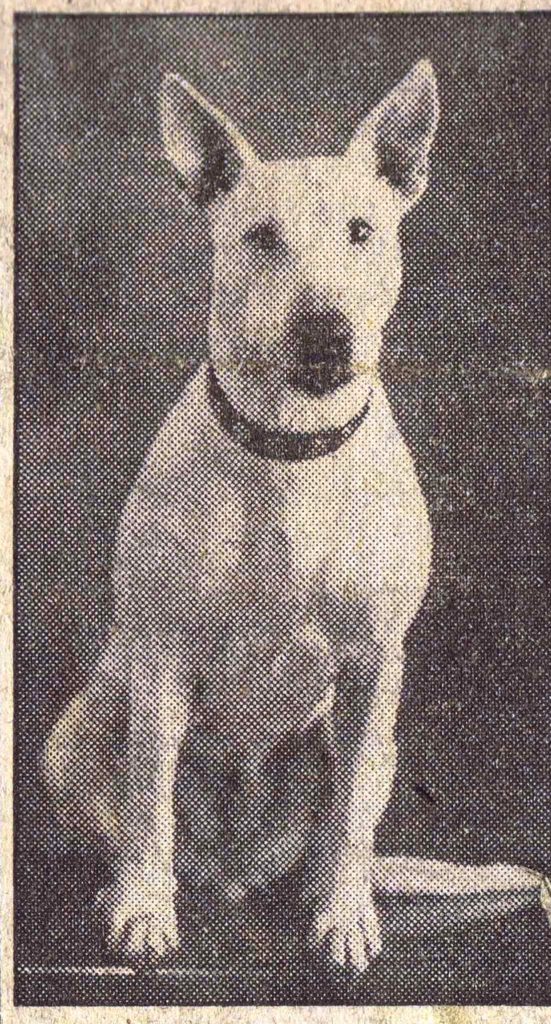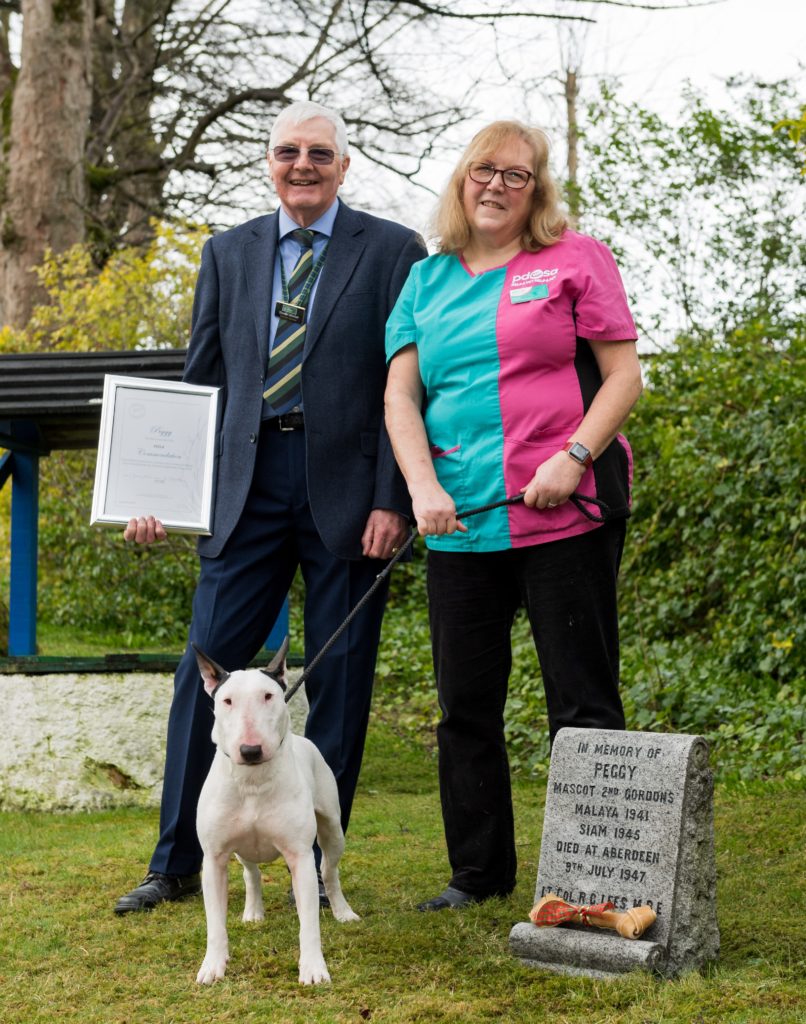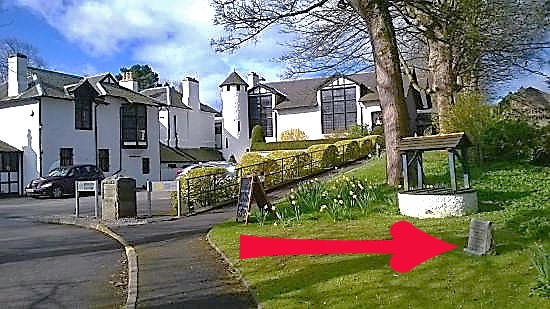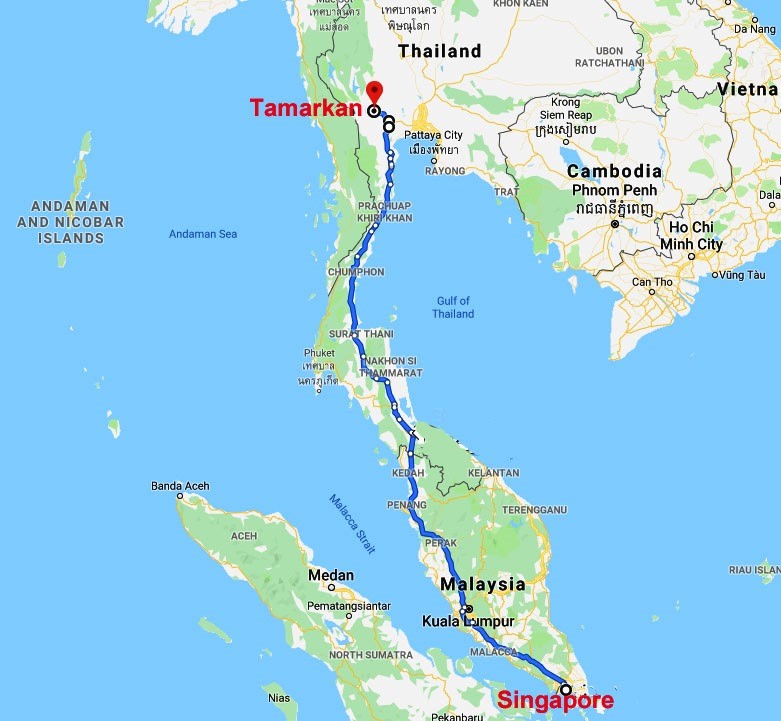
On 20 February 2020, the PDSA presented a special commendation to Peggy the dog for her devotion to The Gordon Highlanders and her bravery.
You can find out her story below…
At their last meeting the People’s Dispensary for Sick Animals (P.D.S.A.) Animal Awards Panel, which administers organisations prestigious animal bravery awards, considered the contribution made by Peggy to the lives of the men of the 2nd Battalion Gordon Highlanders during World War Two. Information had been provided to the Panel by the Gordon Highlanders Museum.
The Panel decided to award a “Commendation” to Peggy for her “unstinting devotion, courage and companionship to those serving with the Gordon Highlanders”. Following this decision,Peggy now joins an illustrious list of animals whose remarkable actions have saved or enriched the lives of their companions. Since the award’s inception in 2001 only 123 of these awards have been made.
Jan McLoughlin, The Director General of the P.D.S.A stated that the Awards panel were fascinated to read the story of how Peggy supported the serving soldiers of the 2nd Battalion Gordon Highlanders in the Far East, displaying devotion, courage and loyalty. (This was during the battle for Malaya and Singapore and subsequently in the horrific conditions of the prisoner of war camps on the infamous Thai-Burma Railway, frequently called the “Death Railway”). She also commented that Peggy was a remarkable dog and her story demonstrates the unique bond that animals and humans share.

Peggy was a pedigree bull terrier adopted by the 2nd Battalion Gordon Highlanders as their mascot. Her story is possibly unique in that she not only accompanied the Gordon Highlanders into battle in Malaya and then became a prisoner of war, after Singapore capitulated to the Japanese, in February 1942. She remained faithful to the Gordon Highlanders for many years despite enduring arduous conditions.
The Gordons were initially forced to work at Tamarkan, Thailand, building a bridge over the River Kwai. It was here that, under a Gordon Highlanders’ bed, which was merely a long platform of bamboo, Peggy gave birth to two black puppies. Tragically these disappeared, believed stolen while the men were out working.
Yhe Japanese fed the PoWs a meagre ration of watery rice three times a day. This contained few, if any, vegetables and rarely any meat. This diet, lacking in vitamins and protein commonly resulted in serious malnutrition and starvation leading to general emaciation which was compounded by various tropical diseases and was often a fatal combination. Peggy also went hungry but learned to eat rice and the men would share some of their meagre ratios with her.
The soldiers were so desperate for sustenance that they were reduced to eating insects and continually searched for any wild fruits or leaves to eat, even although they were potentially poisonous. The sanitary arrangements and hygiene at the Railway camps was primitive and consequently attracted masses of rats. These, in turn, attracted snakes, neither of which, in normal circumstances would be welcome visitors. Peggy came to the rescue. She was naturally adept at catching and killing rats which the PoWs cooked and ate. They were grateful to her for supplying much needed protein, no matter how unappetising this dish would have been under normal circumstances. The control of the rats and subsequent avoidance of the ingress of snakes was a bonus.
In an effort to obtain nutritious food, the PoWs would try to trade with local Thais to obtain a few duck eggs or fruit. They were forced to sell valuable personal, often sentimental items, such as watches, rings or even clothes. Although it was forbidden, the men would steal out of the camp under cover of darkness to trade with local people. The Gordons always took Peggy with them on these missions.
There was great risk in these clandestine enterprises as any PoW caught leaving or returning to the camp was punished very severely. In such an event the poor man would be mercilessly beaten senseless often resulting in the permanent maiming or the death of the unfortunate victim. Peggy was therefore invaluable in these exploits as, with her exceptional hearing and “doggy” sense of smell, she could detect a Japanese guard long before they could and she would alert them of the impending danger.
Peggy also accompanied the men when they went to the railway construction sites. The Japanese demanded their unrealistic work quota had to be met irrespective of the PoWs’ condition, through exhaustion, exacerbated by the malnutrition, and the effects of tropical diseases like malaria and dysentery. The guards were incredibly cruel in these circumstances and would mete out beatings, using with the butt of their rifle or lash them with a split bamboo cane, which could slice their flesh like a razor.
Peggy was a loyal and courageous ally to her Gordon Highlander comrades. When she saw a Gordon Highlander being attacked, she would fearlessly try to intervene, often at the cost of a blow with a split bamboo cane or worse, a stab from a guard’s bayonet. She bore the scars of these encounters for her entire life.
Peggy had another beneficial effect for her Regimental comrades. Her mere presence in the dire conditions of these camps, deep in the Thai jungle, was a huge boost to all of the PoWs. Although intangible, maintaining the morale of the men in the situation they found themselves was vital. In some ways, Peggy’s wellbeing and survival was a focus for the men as a symbol that the Japanese did not control their lives totally. She gave unrestricted loyalty and friendship in a place where faithfulness, affection and hope were in very short supply.
As the construction of the railway progressed, the Gordon Highlander PoWs and Peggy were moved further north into the jungle. The celebrated PoW artist, John (Jack) Mennie, crafted a picture which illustrates Peggy with Gordons and Argylls while in Thailand in 1943. This picture is now held in the collection of the Imperial War Museum, London. This has its own description, in the artists hand writing.
In February 1945, Peggy accompanied a number of Gordon Highlanders to Ubon, Thailand, which is some 600 kilometres east Bangkok. In June 1945, while there, Peggy gave birth to another litter of five pups. This time the pups were protected and they survived until they were all liberated, following the unconditional surrender of the Japanese, on the 15th of August 1945. Their journey home to Britain was by train to Bangkok, followed by flight to Rangoon, Burma, then by ship to Liverpool. For Peggy this did not prove to be straight forward.
Peggy and her brood travelled by train with the Gordons to an airfield near Bangkok. The first obstacle to her travelling home came from the Royal Air Force (RAF) who made it clear that they were not prepared to let the dogs board the planes. Major Reggie Lees stepped in and persuaded the RAF to look after her pups and let Peggy fly. In Rangoon, Peggy was again barred from boarding the ship by the Captain of the vessel which was to take them back to the UK. This caused uproar among the Gordon Highlanders and they refused to board the ship unless Peggy could sail with them. They staged a sit down on the quayside until the Captain relented and allowed Peggy to sail.
After a compulsory period in quarantine in Liverpool, Peggy re-joined the Battalion at the Gordon Barracks, Bridge of Don, Aberdeen. Peggy is reported to have been awarded the same four medals as the men, the 1939-45 Star; Pacific Star; 1939-45 War Medal and Defence Medal. Peggy lived at the Gordon Barracks, Aberdeen and enjoyed being petted and spoiled by the Gordon Highlanders. She stuck close to her old friends who had been Far East prisoners of war (FEPoWs) with her.
Sadly, Peggy died on the 7th of July 1947. Like many of the men she served with, her life was cut short by her experiences while with the PoWs on the infamous Thai-Burma Railway. Peggy was buried at Gordon Barracks. To mark the regard and affection with which Peggy was held by the Regiment, Reggie Lees, by then a Lieutenant Colonel, arranged for a granite headstone to be erected on her grave, which was located near the main entrance to the barracks. This headstone was completed and erected on the 2nd of October 1947 and the local newspaper, “The Aberdeen Press & Journal”, published a story about Peggy with an account of her life which included a photo of Peggy and also her grave being tended by three Gordon Highlanders.

Some time ago, The Gordon Highlanders Regimental HQ and Museum was relocated from Gordon Barracks to Viewfield Road, in the west of Aberdeen. As part of this move it was decided that Peggy would be best commemorated by moving her gravestone, to the grounds of the new Regimental Head Quarters and Museum but not to disturb her grave. Her headstone is just inside the entrance gate to the museum and is passed by every one of the thousands of visitors to the museum and tearoom every year.


Peggy’s place in the history of the Gordon Highlanders is secure and her story and that of her comrades has been fully told in the book “Scattered Under The Rising Sun” by Stewart Mitchell and published by Pen & Sword Books Ltd. The book is available for purchase in The Museum and online at https://gordonhighlanders-dev.5thring.co.uk/shop/books-publications/scattered-under-the-rising-sun/



